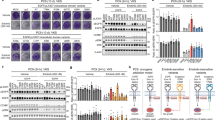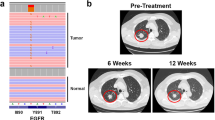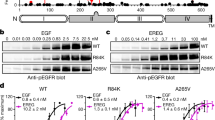Abstract
Several somatic mutations within the tyrosine kinase domain of epidermal growth factor receptor (EGFR) have been identified that predict clinical response of non-small-cell lung carcinoma (NSCLC) patients to gefitinib. To test the hypothesis that these mutations cause constitutive EGF receptor signaling, and to investigate its mechanistic basis, we expressed representative examples in a null background and analysed their biochemical properties. Each mutation caused significant EGF-independent tyrosine phosphorylation of EGFR, and allowed the receptor to promote Ba/F3 cell mitogenesis in the absence of EGF, arguing that these are oncogenic mutations. Active mutated receptors are present at the cell surface and are fully competent to bind EGF. Recent structural studies show that the inactive EGFR tyrosine kinase domain is autoinhibited by intramolecular interactions between its activation loop and αC helix. We find that mutations predicted to disrupt this autoinhibitory interaction (including several that have not been described in NSCLC) elevate EGF-independent tyrosine kinase activity, thus providing new insight into how somatic mutations activate EGFR and other ErbB family members.
This is a preview of subscription content, access via your institution
Access options
Subscribe to this journal
Receive 50 print issues and online access
$259.00 per year
only $5.18 per issue
Buy this article
- Purchase on Springer Link
- Instant access to full article PDF
Prices may be subject to local taxes which are calculated during checkout








Similar content being viewed by others
References
Amann J, Kalyankrishna S, Massion PP, Ohm JE, Girard L, Shigematsu H et al. (2005). Aberrant epidermal growth factor receptor signaling and enhanced sensitivity to EGFR inhibitors in lung cancer. Cancer Res 65: 226–235.
Arteaga CL . (2002). Epidermal growth factor receptor dependence in human tumors: more than just expression? Oncologist 7 (Suppl 4): 31–39.
Biscardi JS, Maa MC, Tice DA, Cox ME, Leu TH, Parsons SJ . (1999). c-Src-mediated phosphorylation of the epidermal growth factor receptor on Tyr845 and Tyr1101 is associated with modulation of receptor function. J Biol Chem 274: 8335–8343.
Burgess AW, Cho HS, Eigenbrot C, Ferguson KM, Garrett TP, Leahy DJ et al. (2003). An open-and-shut case? Recent insights into the activation of EGF/ErbB receptors. Mol Cell 12: 541–552.
Chen YR, Fu YN, Lin CH, Yang ST, Hu SF, Chen YT et al. (2006). Distinctive activation patterns in constitutively active and gefitinib-sensitive EGFR mutants. Oncogene 25: 1205–1215.
Collins MK, Downward J, Miyajima A, Maruyama K, Arai K, Mulligan RC . (1988). Transfer of functional EGF receptors to an IL3-dependent cell line. J Cell Physiol 137: 293–298.
de Larco JE, Todaro GJ . (1978). Epithelioid and fibroblastic rat kidney cell clones: epidermal growth factor (EGF) receptors and the effect of mouse sarcoma virus transformation. J Cell Physiol 94: 335–342.
Dent R, Clemons M . (2006). Trastuzumab after primary treatment for early stage HER2-positive breast cancer reduces recurrence. Cancer Treat Rev 32: 144–148.
Di Fiore PP, Pierce JH, Fleming TP, Hazan R, Ullrich A, King CR et al. (1987a). Overexpression of the human EGF receptor confers an EGF-dependent transformed phenotype to NIH 3T3 cells. Cell 51: 1063–1070.
Di Fiore PP, Pierce JH, Kraus MH, Segatto O, King CR, Aaronson SA . (1987b). ErbB-2 is a potent oncogene when overexpressed in NIH/3T3 cells. Science 237: 178–182.
Ekstrand AJ, Liu L, He J, Hamid ML, Longo N, Collins VP et al. (1995). Altered subcellular location of an activated and tumour-associated epidermal growth factor receptor. Oncogene 10: 1455–1460.
Fabian MA, Biggs 3rd WH, Treiber DK, Atteridge CE, Azimioara MD, Benedetti MG et al. (2005). A small molecule-kinase interaction map for clinical kinase inhibitors. Nat Biotechnol 23: 329–336.
Ferguson KM, Berger MB, Mendrola JM, Cho HS, Leahy DJ, Lemmon MA . (2003). EGF activates its receptor by removing interactions that autoinhibit ectodomain dimerization. Mol Cell 11: 507–517.
Fukuoka M, Yano S, Giaccone G, Tamura T, Nakagawa K, Douillard JY et al. (2003). Multi-institutional randomized phase II trial of gefitinib for previously treated patients with advanced non-small-cell lung cancer (The IDEAL 1 Trial). J Clin Oncol 21: 2237–2246.
Greulich H, Chen TH, Feng W, Janne PA, Alvarez JV, Zappaterra M et al. (2005). Oncogenic transformation by inhibitor-sensitive and -resistant EGFR mutants. PLoS Med 2: e313.
Holbro T, Civenni G, Hynes NE . (2003). The ErbB receptors and their role in cancer progression. Exp Cell Res 284: 99–110.
Hudziak RM, Schlessinger J, Ullrich A . (1987). Increased expression of the putative growth factor receptor p185HER2 causes transformation and tumorigenesis of NIH 3T3 cells. Proc Natl Acad Sci USA 84: 7159–7163.
Hudziak RM, Ullrich A . (1991). Cell transformation potential of a HER2 transmembrane domain deletion mutant retained in the endoplasmic reticulum. J Biol Chem 266: 24109–24115.
Jiang J, Greulich H, Janne PA, Sellers WR, Meyerson M, Griffin JD . (2005). Epidermal growth factor-independent transformation of Ba/F3 cells with cancer-derived epidermal growth factor receptor mutants induces gefitinib-sensitive cell cycle progression. Cancer Res 65: 8968–8974.
Kris MG, Natale RB, Herbst RS, Lynch Jr TJ, Prager D, Belani CP et al. (2003). Efficacy of gefitinib, an inhibitor of the epidermal growth factor receptor tyrosine kinase, in symptomatic patients with non-small cell lung cancer: a randomized trial. JAMA 290: 2149–2158.
Lynch TJ, Bell DW, Sordella R, Gurubhagavatula S, Okimoto RA, Brannigan BW et al. (2004). Activating mutations in the epidermal growth factor receptor underlying responsiveness of non-small-cell lung cancer to gefitinib. N Engl J Med 350: 2129–2139.
Mukohara T, Engelman JA, Hanna NH, Yeap BY, Kobayashi S, Lindeman N et al. (2005). Differential effects of gefitinib and cetuximab on non-small-cell lung cancers bearing epidermal growth factor receptor mutations. J Natl Cancer Inst 97: 1185–1194.
Ozcan F, Klein P, Lemmon MA, Lax I, Schlessinger J . (2006). On the nature of low- and high-affinity EGF receptors on living cells. Proc Natl Acad Sci USA 103: 5735–5740.
Paez JG, Janne PA, Lee JC, Tracy S, Greulich H, Gabriel S et al. (2004). EGFR mutations in lung cancer: correlation with clinical response to gefitinib therapy. Science 304: 1497–1500.
Pao W, Miller V, Zakowski M, Doherty J, Politi K, Sarkaria I et al. (2004). EGF receptor gene mutations are common in lung cancers from ‘never smokers’ and are associated with sensitivity of tumors to gefitinib and erlotinib. Proc Natl Acad Sci USA 101: 13306–13311.
Riese DJ, Kim ED, Elenius K, Buckley S, Klagsbrun M, Plowman GD et al. (1996). The epidermal growth factor receptor couples transforming growth factor-alpha, heparin-binding epidermal growth factor-like factor, and amphiregulin to Neu, ErbB-3, and ErbB-4. J Biol Chem 271: 20047–20052.
Riese 2nd DJ, van Raaij TM, Plowman GD, Andrews GC, Stern DF . (1995). The cellular response to neuregulins is governed by complex interactions of the erbB receptor family. Mol Cell Biol 15: 5770–5776.
Sakai K, Arao T, Shimoyama T, Murofushi K, Sekijima M, Kaji N et al. (2006). Dimerization and the signal transduction pathway of a small in-frame deletion in the epidermal growth factor receptor. FASEB J 20: 311–313.
Schechter Y, Hernaez L, Schlessinger J, Cuatrecasas P . (1979). Local aggregation of hormone-receptor complexes is required for activation by epidermal growth factor. Nature 278: 835–838.
Schreiber AB, Libermann TA, Lax I, Yarden Y, Schlessinger J . (1983). Biological role of epidermal growth factor-receptor clustering. Investigation with monoclonal anti-receptor antibodies. J Biol Chem 258: 846–853.
Shimamura T, Lowell AM, Engelman JA, Shapiro GI . (2005). Epidermal growth factor receptors harboring kinase domain mutations associate with the heat shock protein 90 chaperone and are destabilized following exposure to geldanamycins. Cancer Res 65: 6401–6408.
Slamon DJ, Clark GM, Wong SG, Levin WJ, Ullrich A, McGuire WL . (1987). Human breast cancer: correlation of relapse and survival with amplification of the HER-2/neu oncogene. Science 235: 177–182.
Slamon DJ, Godolphin W, Jones LA, Holt JA, Wong SG, Keith DE et al. (1989). Studies of the HER-2/neu proto-oncogene in human breast and ovarian cancer. Science 244: 707–712.
Slamon DJ, Leyland-Jones B, Shak S, Fuchs H, Paton V, Bajamonde A et al. (2001). Use of chemotherapy plus a monoclonal antibody against HER2 for metastatic breast cancer that overexpresses HER2. N Engl J Med 344: 783–792.
Sordella R, Bell DW, Haber DA, Settleman J . (2004). Gefitinib-sensitizing EGFR mutations in lung cancer activate anti-apoptotic pathways. Science 305: 1163–1167.
Stamos J, Sliwkowski MX, Eigenbrot C . (2002). Structure of the epidermal growth factor receptor kinase domain alone and in complex with a 4-anilinoquinazoline inhibitor. J Biol Chem 277: 46265–46272.
Tice DA, Biscardi JS, Nickles AL, Parsons SJ . (1999). Mechanism of biological synergy between cellular Src and epidermal growth factor receptor. Proc Natl Acad Sci USA 96: 1415–1420.
Ullrich A, Schlessinger J . (1990). Signal transduction by receptors with tyrosine kinase activity. Cell 61: 203–212.
Walker F, Orchard SG, Jorissen RN, Hall NE, Zhang HH, Hoyne PA et al. (2004). CR1/CR2 interactions modulate the functions of the cell surface epidermal growth factor receptor. J Biol Chem 279: 22387–22398.
Wood ER, Truesdale AT, McDonald OB, Yuan D, Hassell A, Dickerson SH et al. (2004). A unique structure for epidermal growth factor receptor bound to GW572016 (Lapatinib): relationships among protein conformation, inhibitor off-rate, and receptor activity in tumor cells. Cancer Res 64: 6652–6659.
Zhang X, Gureasko J, Shen K, Cole PA, Kuriyan J . (2006). An allosteric mechanism for activation of the kinase domain of epidermal growth factor receptor. Cell 125: 1137–1149.
Acknowledgements
We thank Kate Ferguson and members of the Lemmon laboratory for valuable discussions and comments on the paper. This work was supported by NIH grant R01-CA096768 to MAL.
Author information
Authors and Affiliations
Corresponding author
Rights and permissions
About this article
Cite this article
Choi, S., Mendrola, J. & Lemmon, M. EGF-independent activation of cell-surface EGF receptors harboring mutations found in gefitinib-sensitive lung cancer. Oncogene 26, 1567–1576 (2007). https://doi.org/10.1038/sj.onc.1209957
Received:
Revised:
Accepted:
Published:
Issue Date:
DOI: https://doi.org/10.1038/sj.onc.1209957
Keywords
This article is cited by
-
Molecular recognition of tak-285 and lapatinib by inactive, active, and middle active-inactive HER2
Journal of Molecular Modeling (2021)
-
Investigation of therapeutic modalities of G719X, an uncommon mutation in the EGFR gene in non-small cell lung cancer
Oncology and Translational Medicine (2019)
-
Lupeol evokes anticancer effects in oral squamous cell carcinoma by inhibiting oncogenic EGFR pathway
Molecular and Cellular Biochemistry (2016)
-
Functional Role of Histidine in the Conserved His-x-Asp Motif in the Catalytic Core of Protein Kinases
Scientific Reports (2015)
-
In vivo activation of the PI3K–Akt pathway in mouse beta cells by the EGFR mutation L858R protects against diabetes
Diabetologia (2014)



